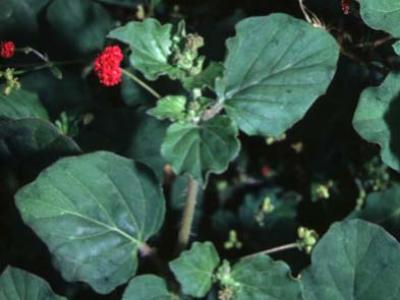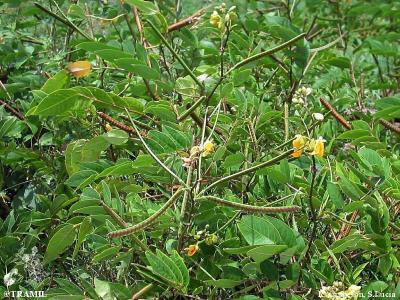(In territories with significant traditional TRAMIL use)
Martinique:
- patagon
feuille, jus, gargarismes1
feuille, décoction, gargarismes1
According to the information available:
The use for sore throat is classified as REC based on the significant traditional use documented in the TRAMIL surveys, the toxicity studies, validation and the scientific information published.
Not for use during pregnancy, breastfeeding or in children under 10 years of age.
The leaves of Boerhavia diffusa are a food of relatively widespread human consumption in India.
For sore throats:
prepare a decoction with 30 grams of fresh leaves in 4 cups (1 litre) of water, boil for 10 minutes in a covered vessel. Cool, strain (filter) and gargle 3 times a day.
For use of the leaf juice:
Adequately wash 30 grams of leaf and crush in a mortar with a little water (approximately 15 cubic centimetres) until the juice is pressed out. Pour into a spoon and gargle. Repeat 3 times a day.
Preparations must never be stored for more than 24 hours, even if refrigerated.
1 LONGUEFOSSE JL, NOSSIN E, 1990-95
Enquête TRAMIL. Association pour la valorisation des plantes médicinales de la Caraïbe AVPMC, Fort de France, Martinique.
2 Beltran C, Jimenez S, GOmez A, BeltrAn J, GarcIa G, GOmez H, 2010
screening fitoquimico de hoja de Boerhaavia diffusa (infusión, deccoción y extracto etanólico (maceración). Trabajo TRAMIL. Grupo de Investigación en Química de Medicamentos, Universidad de Cartagena, Colombia.
3 AGARWAL RR, DUTT SS, 1934
Chemical examination of punar-nava or Boerhavia diffusa Linn. Proc Acad Sci 4:73-76.
4 MATHAMS RH, SUTHERLAND AK, 1952
The oxalate content of some Queensland pasture plants. Queensland J Agric Sci 9:317-334.
5 AHMAD K, HOSSAIN A, 1968
Isolation, structure, synthesis and biological action of hypoxanthine-9-L-arabinofuranoside. Pak J Biol Agr Sci 11(2):41-44.
6 AGARWAL RR, DUTT SS, 1935
Chemical examination of punarnava or Boerhavia diffusa Linn. II Isolation of an alkaloid punarnavine. Proc Acad Sci United Provinces Agra Audh India 5:240-242.
7 BASU NK, LAL SB, SHARMA SN, 1947
Investigations on Indian medicinal plants. Q J Pharm Pharmacol 20(1):38-42.
8 SRIVASTAVA DN, SINGH RH, UDUPA KN, 1972
Studies on the Indian indigenous drug, punarnava (Boerhavia diffusa Linn.). Part V. Isolation and identification of a steroid. J Res Indian Med 7(3):34-36.
9 ROIG J, 1988. Plantas Medicinales, Aromáticas y Venenosas de Cuba. 2a ed. La Habana, Cuba: Editorial Científico-Técnica.
10 FERRERES F, SOUSA C, JUSTIN M, VALENTÃO P, ANDRADE PB, LLORACH R, RODRIGUES A, SEABRA RM, LEITÃO A, 2005
Characterisation of the phenolic profile of Boerhaavia diffusa L. by HPLC-PAD-MS/MS as a tool for quality control. Phytochem Anal 16(6):451-458.
11 PEREIRA DM, FARIA J, GASPAR L, VALENTÃO P, DE PINHO PG, ANDRADE PB, 2009
Boerhaavia diffusa: metabolite profiling of a medicinal plant from Nyctaginaceae. Food Chem Toxicol 47(8):2142-2149.
12 CACERES A, GONZALEZ S, GIRON L, 1998
Demostración de la actividad antimicrobiana de plantas TRAMIL en base a los usos populares en la cuenca del Caribe. Laboratorio de productos fitofarmacéuticos Farmaya y Facultad de Ciencias Químicas y Farmacia, Universidad de San Carlos, Guatemala, Guatemala.
13 SOUZA BRITO AR, HIRUMA-LIMA CA, 1996
Toxicidade aguda e atividade analgésica de estratos brutos de plantas do Caribe. Informe TRAMIL. Dep. de Fisiología y Biofísica, Universidad de Campinas, Campinas, Brasil.
14 HIRUMA-LIMA CA, GRACIOSO JS, BIGHETTI EJB, GERMOSEN-ROBINEAU L, SOUZA BRITO AR, 2000
The juice of fresh leaves of Boerhavia diffusa L. (Nyctaginaceae) markedly reduces pain in mice. J Ethnopharmacol 71(1/2):267-274.
15 AYNEHCHI Y, SALEHI SORMAGHI M, SHIRUDI M, 1982
Screening of Iranian plants for antimicrobial activity. Acta Pharm 19(4):303-308.
16 ORISAKWE OE, AFONNE OJ, CHUDE MA, OBI E, DIOKA CE, 2003
Sub-chronic toxicity studies of the aqueous extract of Boerhavia diffusa leaves. J of Health Science 49(6)444-447.
17 CHANDAN BK, SHARMA AK, ANAND KK, 1991
Boerhavia diffusa: a study of its hepatoprotective activity. J Ethnopharmacol 31(3):299-307.



